An Investigation into EFL Teachers’ Attitudes towards the Communicative Language Teaching in Vietnam
Minh Ngoc Tran and Hau Trung Ho, Vietnam
Minh Ngoc Tran is currently a lecturer in the Department of Foreign Languages at the University of Thu Dau Mot, Binh Duong Province, Viet Nam. She has a Master’s degree in TESOL from the University of Social Sciences and Humanities – Ho Chi Minh National University, Vietnam. Her research interests include linguistics, interpreting, and incorporating literature into English language teaching. E-mail: minhtn@tdmu.edu.vn
Hau Trung Ho holds a Master’s degree in TESOL at the University of Social Sciences and Humanities – Ho Chi Minh National University, Vietnam. He is currently teaching English at the University of Thu Dau Mot, Vietnam. His major research interests include pragmatics and EFL methodology. He has also participated in designing a textbook in phonetics and applying CDIO approach in developing curriculum in the past few years. E-mail: hauht@tdmu.edu.vn
Menu
Abstract
Background of the study
Statement of the problem
Research questions
Some practical problems in the application of CLT
Model of CLT
Methodology
Data analysis
Discussion of results
Recommendations
References
Appendices
Communicative language teaching (CLT) has received wide recognition from educational researchers as an effective EFL teaching method. However, the application of this teaching method is still limited in Vietnam. With the intent of enhancing the application of CLT, the current study was carried out to explore the teachers’ and learners’ attitudes towards its theory and application, as well as the actual application of this teaching method at the foreign language center of the University of Social Sciences and Humanities, Ho Chi Minh city, Vietnam. Data for the study were collected from questionnaire to 33 teacher respondents and 5-class observation. The findings indicated that the teacher participants generally had highly favourable attitudes towards CLT. Furthermore, the teachers articulated a number of constraints that hampered the effective accomplishment of CLT. The results, although tentative, contribute to an understanding of the reality of using CLT in Vietnam and provide suggestions for the concerned bodies to facilitate the process of applying this teaching method in this institution.
With the rapid development of the economy of Vietnam, English is becoming a hit in our social scenario. It is a vehicle for communicating and exchanging information with the outside world. Hence, recently, a shift toward more communicative and eclectic approaches of foreign language teaching in Vietnam has led to a change in instructional styles allotting more classroom time for students to actively communicate with one another. This innovative method is known as Communicative Language Teaching (CLT). As postulated by Brown (2000, p.266), CLT is considered to be the best teaching method “to ensure successful language teaching”. Learners must have the ability to use both forms and functions properly for establishing meaningful communication.
Although CLT has been used for many years, teachers in Vietnam have not widely adopted it yet. Rather, they still depend on traditional teaching methods. Tran, Thi Thu Trang & Baldauf (2007) point out an undesirable reality that, in the context of Vietnam, teachers feel pressures from parents and school administrations to prove that their students have learned enough to pass entrance exams to reputable schools, and that they are competent educators based upon students’ scores on standardized tests. Consequently, teachers stick to the textbooks, lecturing on the finer points of grammar for the purpose of clear communication, involving little communication amongst the students for developing communicative competence. Many studies have suggested that teacher-dominated classes instead of learner-centered classes prevent students from practicing oral skills effectively (Edwards, 1987; Pace, 1992) and that the traditional grammar-translation method “failed to develop an adequate level of communicative competence (i.e. the ability to use the target language for authentic communication)” (Hu, 2002, p.93). In Vietnam’s educational system, although English is a compulsory subject in high schools and at universities, many high school pupils, after years of learning English, find themselves unable to communicate in a natural way in the target language even in simple situations or face up with communication breakdown. Those learners obviously have fairly good knowledge of linguistics, but they find working with English a terribly demanding and challenging task.
The courses of English at the Foreign Language Center of the University of Social Sciences and Humanities (FLC-USSH) in Vietnam aim to prepare learners for A, B or C national certificates in English. The examinations for these certificates assess learners on all four skills: reading, writing, listening and speaking. It is expected that, after graduation, the learners can communicate effectively in English. In spite of the fact that learners manage in some way to get the certificates, it is clear that the wide application of traditional teaching method, as just described above, is not quite suitable for the teaching and learning purposes at FLC-USSH.
The question about the enhancement of the teaching and learning quality of English at FLC-USSH with respect to the effective implementation of CLT in this institution, therefore, captured the researcher’s concerns and generated ideas from which this study came into being.
It is quite clear that an appropriate teaching method will be beneficial to both the teachers and learners in general. CLT is a prominent theoretical method in EFL teaching and has been widely recognized by many educational scholars (Pica, 2000; Brown, 2000) to be such a good teaching method, as discussed in the previous section.
However, it is certain that some problems still exist in the process of applying this teaching method, especially at FLC-USSH. As stated above, the application of this method in actual teaching is still rather limited in this language institution. Another concern touches upon the practical constraints that may hamper the efficacious implementation of CLT. These deficiencies have prompted the author of the thesis to consider possible solutions and conduct the present study.
The main purpose of this study is to seek for the possible answers to the two research questions which are formulated as follows:
- What are the teachers’ attitudes towards the theory of CLT at FLC-USSH?
- To what extent is CLT applied to the teaching of English at FLC-USSH?
When it comes to the practical problems in the application of CLT, Hui (1997) classifies these problems into five salient constraints which are: economic, administrative, cultural, population, and teachers’ academic ability. Firstly, in stating the economic factors, Hui means the unavailability of resources, such as: audio-visual laboratories, photocopying… Secondly, the influence of administrators is observed, especially when teaching performances are evaluated, the focus is on the teachers rather than students and their learning processes. Thirdly, by cultural factors, he also reports that students in China are reluctant to air their views loudly for fear of losing face or offending others. Fourthly, population factors refer to large English-learning population (students). These large numbers of students create over-crowded classrooms which leave hardly any room for free communicative activities, especially which require moving around. Finally, by teachers’ academic ability, he states that there are not enough opportunities for every teacher to systematically study linguistic theories and theories of second language acquisition.
A model of teaching method was proposed by Anthony in 1963. He identified three levels of conceptualization and organization termed Approach, Method and Technique. However, Richards & Rodgers (2001) suggest that this model fails to give sufficient attention to the nature of a method itself. Therefore, Richards & Rodgers paraphrased, revised and enlarged the original Anthony’s model. They combined the two levels of Method and Technique into the level of Design; the level of Technique is referred to by a slightly more comprehensive term Procedure. In describing a teaching method, Larsen-Freeman (2004) also follows the model of a method by Anthony (1963). She reviewed a few principles of CLT underlying the behaviors of a class for high-intermediate immigrants in Canada.
Figure 1 in the next page summarizes and synthesizes the model and principles of CLT as proposed by Richards & Rodgers (2001) and Larsen-Freeman (2004).
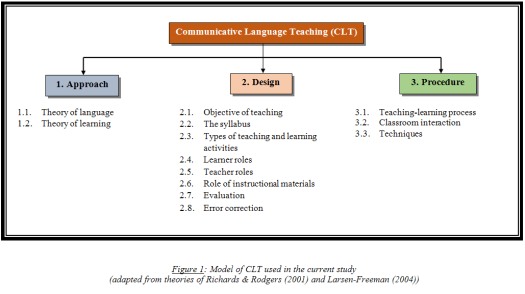
Theory of language
Richards & Rodgers (2001) postulate that CLT starts from a theory of language as communication. According to Savignon (2007), although communication might come into view as face-to-face oral interaction, it also embodies writing and reading activities. Her statement clearly implies that communication takes place not only among speakers and listeners but also writers and readers as well.
In her study, Larsen-Freeman (2004), also based upon the theory of language, extends this component and gives out a more specific description of some characteristics of CLT, which includes the role of culture in language learning, the importance of four language skills, the use of mother tongue and target language in classroom. Her description is as follows:
Firstly, culture plays an important role in developing learners’ communicative competence. In other words, in teaching a language, it is crucial to teach the culture of its people. Secondly, although in CLT language functions are emphasized over forms, CLT is not limited to oral skills but includes reading and writing skills, too. It is important to recognize that it is not only the speaker (or writer) who is communicating. Thirdly, the students’ native language (L1) has no particular role in CLT.
However, Cook (2001) believes that teachers who manage to use both target language and learners’ mother tongue can serve as a model of successful bilingual. They are able to use the two languages effectively since each language serves a different function in classroom. From the personal viewpoint of the author of this study, mother tongue should be used in a limited fashion in communicative classroom; however, it should not be devalued or completely omitted in EFL teaching context.
Theory of learning
In considering the conditions that need to be met in order for learning processes to be activated, Richards & Rodgers suggest three underlying principles: (i) the communication principle which states that activities that involve real communication promote learning, (ii) task principle which states that activities in which language is used for carrying out meaningful tasks promote learning (Johnson, 1982), and (iii) the meaningfulness principle which states that language that is meaningful to the learner supports the learning process.
Concerning the matter of language acquisition, Savignon (1983) stresses the vital role of linguistic, social, cognitive, and individual variables. This view supports Stern (1983, p.261)’s claim that “the learner must become a participant in a real-life context of language use as a condition of effective learning”. This view once again emphasizes the important function of real communication in EFL classroom.
Objectives of teaching
Larsen-Freeman (2004) argues that the goal of teaching is to have one’s students become communicatively competent. To achieve such a goal, students need knowledge of the linguistic forms, meanings, and functions. This is because “many different forms can be used to perform a function and also that a single form can often serve a variety of functions.” However, CLT gives primary importance to the use or function of the language and secondary importance to its structure or form (Larsen-Freeman, 2004). The implication in this idea is that emphasis is also given to meaning (messages they are creating or task they are completing) rather than form (correctness of language and language structure). Meaning is important since it helps the learners to manage the message they engage with the interlocutors.
The syllabus
According to Richards & Rodgers, the term ‘syllabus’ has been used to refer to the form in which linguistic content is specified in a course or method. Allen (1984, p.64) shares the view when asserting that the selection of materials is based upon objectives, duration of course, and level. Hence, syllabus concerns mainly with choice about language content and its organization.
As stated by Richards & Rodgers, the discussion of syllabus models in CLT is quite extensive. Some researchers even recommend that “the syllabus concept be abolished altogether in its accepted forms” (Richards & Rodgers, 2001). The use of one syllabus or another, thus, seems very difficult to justify.
Types of learning and teaching activities
Richards & Rodgers (2001, p.76) state that the range of exercise types and activities compatible with a communicative method is unlimited, provided that such exercises enable learners to attain the communicative objectives of the curriculum, engaging learners in communication, and requiring the use of such communicative processes as information sharing, negotiation of meaning, and interaction.
Learner roles
Learners have a paramount role to play in communicative classrooms. Richards & Rodgers (2001, p.76) rightly believes that CLT puts more emphasis on the process of communication (rather than mastery of the language forms) leads to different roles for learners. Harmer, J. (1991, p.4) shares the point when aptly stating that getting students to speak is a vital part of a teacher’s job, and a good teacher maximizes student talking time and minimizes teacher talking time.
Breen and Candlin (1980, p.110) advances the understanding of learner roles within the CLT by describing their roles in the following terms: “The role of learner as negotiator – between the self, the learning process, and the object of learning – emerges from and interacts with the role of joint negotiator within the group and within the classroom procedures and activities”. From the view of Breen and Candlin, learners do most of the speaking in classroom. They are encouraged to participate in the communicative activities actively.
Teacher roles
CLT pays much attention to the needs of learners and the objective is to engage learners’ interests and enjoyment in the language learning process. Teachers, therefore, have to avoid the traditional authoritarian role so that learners can have opportunities to manage their own learning (Larsen-Freeman, 2000, p.129).
Besides, Larsen-Freeman confirms that the teacher’s role is less dominant than the learner’s role. Taylor (1983 in Defeng, 1998, p.679) also adds that teacher-led instruction is not recommended as it gives fewer opportunities for learners to interact than in learner-centered instruction. In other words, it is the learner who plays a great role in a large proportion of the process of learning.
Altan & Trombly (2001, p.29) also shows agreement by saying: “The teacher-dominated classroom is characterized by the teacher’s peaking most of the time, directing all the activities, and constantly passing judgment on learners’ performance, whereas in a highly learner-centered classroom, learners will be observed working individually or in pairs and small groups”. In other words, classroom discourse should not be dominated by teacher talk with few contributions from learners.
The role of instructional materials
Larsen-Freeman says that when it is committed to materials in CLT, authentic materials should be used. Brown (2000) asserts that English teaching materials are considered authentic when they are used according to the levels of the students and also when students can relate the topics of those materials with their background knowledge and they can see the relationship of those topics with real life.
Evaluation
Although evaluation in EFL learning and teaching plays an important role, Richards & Rodgers say nothing about evaluation in communicative classrooms.
However, Larsen-Freeman puts forward a fairly practical description of evaluation. According to her, evaluation is carried out in terms of both fluency and accuracy. Students who have the most control of the structures and vocabulary might not be successful communicators. In formal evaluation, a teacher is likely to use a communicative test, which is an integrative and has a real communicative function (e.g., Madsen, 1983; Hughes, 1989). A teacher can also informally evaluate his students’ performance in his role as an advisor or co-communicator (Larsen-Freeman, 2004). For formal evaluation, a teacher is likely to use a communicative test.
Error correction
Errors are considered to be unavoidable when learning a language and developing communicative competence. Brown (2000, p.217) defines an error as “a noticeable deviation from the adult grammar of a native speaker [that] reflects the competence of the learner”. Error reflects the level of L2 learners’ proficiency.
According to Richards & Rodgers, correction of errors may be absent or infrequent. Larsen-Freeman (2004) also has the same viewpoint when stating that errors of form are tolerated and are seen as a natural outcome of the development of communication skills. Students can have limited linguistic knowledge and still be successful communicators. Error correction has to be kept to a minimum and priority should be given to errors that hamper communication, as the aim is to develop learners’ communicative fluency.
Teaching-learning process
According to Larsen-Freeman (2009), the most obvious feature of CLT is that almost everything is done with a communicative intent. Students use the language a great deal through communicative activities such as games, role-plays, and problem-solving tasks.
Another characteristics of CLT is that communicative activities are often carried out by students in small groups. More emphasis should be given to active modes of learning such as pair or group work in problem-solving tasks. This helps to maximize the time allotted to each student for learning to negotiate meaning.
Also, one important characteristics of CLT to be put into account is the use of authentic materials. It is considered desirable to give students an opportunity to develop strategies for understanding language as it is actually used by native speakers in their daily life.
Classroom interaction
Larsen-Freeman (2004) uncovers that the teacher is the facilitator of the activities, the manager of classroom activities, a co-communicator, an independent participant. Meanwhile, students interact a great deal with one another. They try to make themselves understood with incomplete knowledge of the target language; at the same time, they also manage to understand their partner(s). They do this in various configurations: pairs, triads, small groups, and whole group. Celce-Murcia (1991) also argues that students regularly work in groups or pairs to transfer (and if necessary to negotiate) meaning in situations where one person has information that others lack. In other words, it’s the students that do most of the communication in communicative classroom.
Techniques
According to Richards & Rodgers (2001), description of typical classroom procedures used in a lesson based upon the CLT principles is not feasible. There are many reasons for this. The first reason is that communicative principles can be applied to the teaching of any skill, at any level; the second one is that there are many classroom activities and exercise types used in a communicative classroom. Savignon (1983) gives some discussion about the techniques and classroom procedures (e.g., group activities, language games, role-plays, and so on). However, none of these techniques and activities is designed specifically for communicative classroom.
Respondents of the study
Totally, there were 33 English teachers at FLC-USSH participating in the investigation. The researcher assumed that the teachers who were using CLT would have more experience in the application of this method; as such, they could give more appropriate responses and the data collected from these teachers would be more accurate and reliable. On that basis, a criteria was set up as follows: only those teachers who were applying CLT to their teaching at FLC-USSH were selected for the investigation.
Questionnaire to teacher respondents
The questionnaire to teacher respondents was conceptualized in four main parts. Part A, which covered 6 questions, was intended to explore the demographic data of teacher respondents. Part B was designed to elicit the teacher respondents’ attitudes towards the theory of CLT, including 33 statements in total. Part C was formulated to elicit information about the frequency of the implementation of some major characteristics of CLT in actual teaching, consisting of 20 items. In both part C and D, the teacher had to respond according to a five-point Likert-type scale. Besides, part D sought to explore some practical problems in the application of CLT.
Observation
In order to focus upon some specific behaviors and not to be distracted by other activities which were not the concerns of the study, a checklist was prepared in advance. All the 18 items in the checklist focused upon behaviors and activities that were thought to be explicitly observable in classrooms.
Teachers’ attitudes towards the theory of CLT
Theory of language and Theory of learning
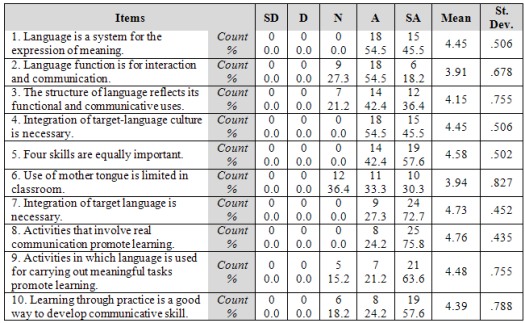
Table 1: Teachers’ attitudes towards the theory of CLT in terms of Theory of language and Theory of learning
Table 1 shows the average mean score M = 4.32 for Theory of language and M = 4.54 for Theory of learning. All of the 33 teacher respondents showed favorable attitudes towards the statements about the language system (M = 4.45), language function (M = 3.91) and language structure (M = 4.15). A small number of the responses to the statements about the language function (27.3%), language structure (21.2%), the use of mother tongue (36.4%), the use of communicative activities (15.2%) and learning through practice (18.2%) were recorded as being neutral. Although there were a small number of responses recorded as neutral, most of the teacher respondents had a good perception of theoretical aspect of CLT, identifying Theory of language and Theory of learning as their guiding theories in the process of teaching.
Objective of teaching and The syllabus

Table 2: Teachers’ attitudes towards the theory of CLT in terms of Objective of teaching and The syllabus
In general terms, the teachers showed positive attitude towards the investigated issues (the average mean score M = 4.66 for Objective of teaching). There was full agreement whereas only a small number of the respondents had neutral attitudes. These findings may suggest that the objective of teaching in CLT quite satisfied the teacher respondents. However, a small number of the teacher respondents did not display support to a statement in The syllabus. More specifically, 12.1% of the teacher respondents showed neutral responses to the statement about the use of different kinds of syllabuses. This finding might indicate that those teachers were somewhat uncertain about this use of syllabuses as suggested by CLT’s principles in their classrooms.
Teacher roles and Learner roles

Table 3: Teachers’ attitudes towards the theory of CLT in terms of Learner roles and Teacher roles
As can be seen in Table 3 above, the overall responses from the teacher respondents to the attitudinal statements about these components were mainly positive (the average mean score M = 4.35 for Learner roles and M = 4.7 for Teacher roles). The average mean scores were really high. It might be concluded that a majority of the respondents not only favored the use of communicative activities/tasks in their classroom but also supported the change in the dominance of the teachers’ role.
Types of teaching and learning activities and Role of instructional materials

Table 4: Teachers’ attitudes towards the theory of CLT in terms of Types of teaching and learning activities and Role of instructional materials
Evidently from Table 4 that, in general, the teachers were positive about these components of CLT (the average mean score M = 4.39 for Types of teaching and learning activities, and M = 4.73 for Role of instructional materials). However, 15.2% of the teacher respondents showed neutral attitudes towards the use of activities engaging learners in communication. This finding could be interpreted to mean that a small number of the teacher respondents were still hesitant in providing their learners with the communicative activities.
Generally speaking, the central tendency is that Types of teaching and learning activities and Role of instructional materials are quite satisfactory to the teacher respondents.
Evaluation and Error correction
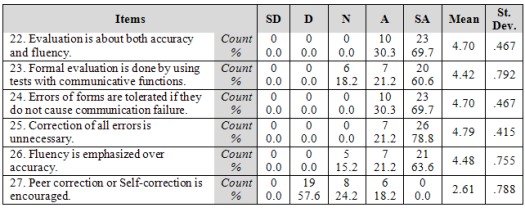
Table 5: Teachers’ attitudes towards the theory of CLT in terms of Evaluation and Error correction
The teacher respondents were satisfied with these two components of CLT (the average mean score M = 4.56 for Evaluation and M = 4.15 for Error correction). To be more specific, 100% of the teacher respondents (i.e. a total of 33 teachers) showed favorable attitudes in response to the evaluation based upon accuracy and fluency (M = 4.70), tolerance of learners’ errors (M = 4.70), and correction of all error (M = 4.79). However, the statement about the value of self-correction did not seem to be favored by many teacher respondents. That is, 81.8% of the teacher respondents were uncertain or against to the idea of encouraging self-correction by showing neutral attitudes or disagreeing on this practice. This finding may reflect that explicit correction was more favorable to these teacher respondents in their communicative classroom.
Overall, except for the statement about self-correction, the teacher respondents highly stressed the value of CLT’s theory in terms of Evaluation and Error correction.
Teaching-learning process, Classroom interaction and Techniques
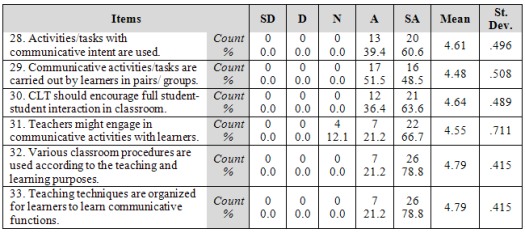
Table 6: Teachers’ attitudes towards the theory of CLT in terms of Teaching-learning process, Classroom interaction and Techniques
The overall responses garnered to these components were considerably positive (the average mean score M = 4.55 for Teaching-learning process, M = 4.6 for Classroom interaction and M = 4.79 for Techniques). The central tendency addresses that these respondents were quite satisfied with the use of communicative activities in their classroom and that student-student interaction should be encouraged. The organization of teaching techniques and procedures in CLT also received favorable attitudes from the teacher respondents.
Neutral attitudes, although not quite considerable, were also identified. The statement that teachers might engage in communicative activities with learners received the neutral attitudes from 12.1% of the teacher respondents. This fact gives a slight suggestion that a small number of the teacher respondents were rather reluctant to engage in communicative activities with their learners.
Teachers’ responses to the application of CLT at FLC-USSH
Types of teaching and learning activities, and Role of instructional materials

Table 7: Teachers’ responses to the application of CLT in terms of Types of teaching and learning activities, and Role of instructional materials
As can be seen from Table 7 above, the teaching reality expressed in the statements either rarely or sometimes happened in classrooms (the average mean score M = 2.73 for Types of teaching and learning activities and M = 3 for Role of instructional materials). In details, the teacher respondents indicated materials promoting authentic communication (M = 3.03) were sometimes used in classroom. This finding might indicate that there was the absence of one of the most important features of CLT in classroom: the use of authentic texts.
The teachers went on to state that activities engaging learners in meaningful communication and various kinds of materials were rarely exploited (M = 2.73 and M = 2.97, respectively). These findings might indicate that the communication activities were frequently skipped in classroom, and the flexibility in using kinds of syllabi was hardly found. The application of CLT was limited in terms of Types of teaching and learning activities, and Role of instructional materials.
Learner roles and Teacher roles
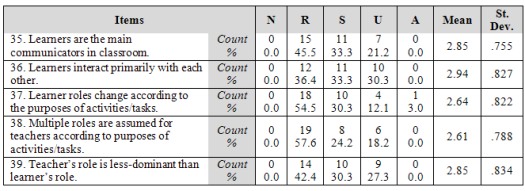
Table 8: Teachers’ responses to the application of CLT in terms of Learner roles and Teacher roles
The practices of CLT as expressed in the statements rarely happened in classrooms with the average mean score M being 2.81 for Learner roles and 2.73 for Teacher roles). To be more specific, the teacher participants affirmed that the following practices were rarely followed in the classrooms: learners being the main communicators in classroom (M = 2.85), learners’ interaction (M = 2.94), change of learner roles (M = 2.64), teachers’ multiple roles (M = 2.61), and teacher’ less dominant role (M = 2.85). On the whole, these results might reveal that the teacher respondents still dominated the classroom discourse and occupied most speaking time in classroom. Besides, learners were not endowed with ample time for communication and interaction in classrooms.
Evaluation and Error correction
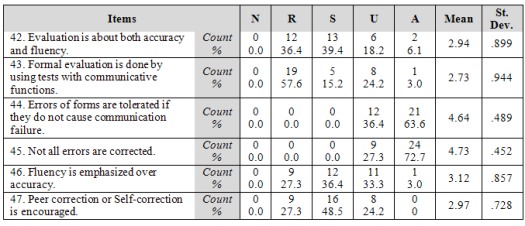
Table 9: Teachers’ responses to the application of CLT in terms of Evaluation and Error correction
On the whole, the respondents insisted on the low frequency of the practice presented under Evaluation (the average mean score M = 2.84). However, the practices under Error correction were accepted to be of high frequency by most of the teacher respondents (the average mean score M = 3.87). Most of the teachers confirmed that the following practices were usually or always followed in classroom: the tolerance of errors of forms (M = 4.64), the correction of all errors (M = 4.73), and the dominant role of fluency over accuracy (M = 3.12).
Furthermore, it is so interesting that Error correction was recorded as being of both high and low frequency from the teacher respondents. That is, although other statements about the Error correction were frequently used in classroom, self-correction was identified as rarely happening (M = 2.97). Briefly, the practices of CLT in terms of Error correction were widely applied, but the practices of CLT in terms of Evaluation were fairly limited.
Teaching-learning process, Classroom interaction and Techniques
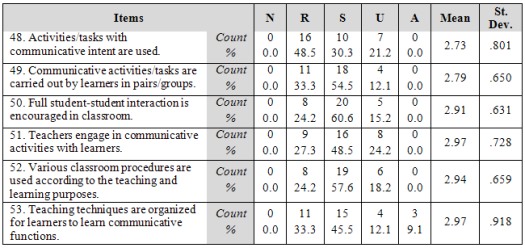
Table 10: Teachers’ responses to the application of CLT in terms of Teaching-learning process, Classroom interaction and Techniques
The teachers overall agreed on the low frequency (rarely) of these three components of CLT in classroom at FLC-USSH (the average mean score M = 2.76 for Teaching-learning process, M = 2.94 for Classroom interaction, and M = 2.96 for Techniques). More specifically, the teacher respondents reported that the following practices were not fully exploited in their classrooms: the activities with communicative intent (M = 2.73), pair/group work (M = 2.79), student-student interaction (M = 2.91), teachers engaging in communication (M = 2.97), the arrangement of classroom procedures (M = 2.94) and teaching techniques (M = 2.97) for communication. It might be inferred that the learners’ interaction was not fully supported through organizing teaching techniques in classroom.
Practical problems in the application of CLT
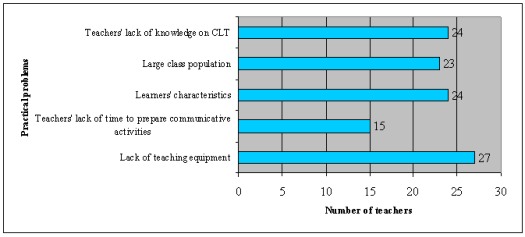
Figure 2: Problems in the application of CLT
Figure 2 above identifies some practical problems in the process of implementation of CLT, as perceived by the teacher subjects. It is clear that the most common problems were lack of teaching equipment (27 out of 33 teachers), teachers’ lack of knowledge on CLT and learners’ characteristics (24/33 teachers), large class population (23/33 teachers), and teachers’ lack of time to prepare activities (15/33 teachers). These findings strongly suggest that the teaching facilities at FLC-USSH were not enough to create convenient environment for communicative classroom; and the teachers really need to be provided with professional knowledge on CLT.
Not only that, the language used in teaching may also be a problem as shown in Figure 3 below:

Figure 3: Main language used in teaching
Figure 3 above presents information about the main language used by the teachers in their classrooms. Overall responses signified that Vietnamese was used the most in classroom with the support from 16 out of 33 (49%) teacher respondents. Furthermore, only 24% of the teacher respondents reported that they used English as the main language in their teaching. It can be concluded that English was not frequently used in classroom.
Teachers’ attitudes towards the theory of CLT
The first level to be considered is the level of Approach. In responding to the statement about the equal importance of four skills in classroom, a large numbers of teacher respondents also showed strong agreement. In fact, communication took place in both the written and spoken medium. In other words, it is important to recognize that it is not only the speaker (or writer) who is communicating. If the teachers do not recognize the importance of the four skills and pay fair attention to them, their learners cannot be effective communicators in real-life context.
A vast majority of the teacher respondents agreed that target language and target culture should be integrated in their teaching. Actually, the integration of target-language culture and the encouragement of the use of target language (i.e. English) are considered to be a major factor that helps develop EFL learners’ communicative competence. Besides indicating the teacher respondents’ attitudes towards the fundamental guiding theories of CLT, those findings also help reveal the teacher participants’ perception of CLT in terms of Approach component. That is, they perceived that the ideas of this component were useful and served as the guide in their teaching.
The components under the level of Design also satisfied those teacher respondents. For example, the teachers quite agreed that the goal of their teaching was to develop learners’ communicative competence and that the communicative activities should be employed in classroom. This perception of the EFL teachers at this center plays a vital part in developing learners’ communicative competence, since it might guide the teachers’ actual behavior in providing more opportunities for learners’ interaction and communication.
The responses were also recorded as positive for the most of the components under the Procedure level. Most of the teacher respondents showed agreement to the use of communicative activities and the interaction among learners. Besides, the organization of teaching techniques that support learners’ communication also received favorable disposition from the involved teachers.
Although the teacher respondents showed positive attitudes towards most of the components of CLT, a majority of those teachers expressed little support for some statements. For example, some respondents displayed neutral attitude towards the fact that learning through practice is a good way to develop learners’ communicative competence. This perception may prevent the EFL teachers at this language center from providing their learners with opportunities for communication and interaction.
Finally, some teacher respondents showed little satisfaction for the fact that fluency (language use) is emphasized over accuracy (language form) in classroom. In fact, “fluency and accuracy are seen as complementary principles underlying communicative techniques” (Brown, 1994, p.245). However, at times fluency may have to take on more importance than accuracy because “fluency and acceptable language is the primary goal” (Finocchiaro & Brumfit, 1983, p.93). Hence, the teachers should be noted that fluency is emphasized over accuracy in order to keep learners meaningfully engaged in language use.
Overall, despite some uncertain and/or neutral attitudes, the teacher respondents responded really positively to the theory of CLT.
The application of CLT at FLC-USSH
The application of CLT was considerably limited at FLC-USSH. Most of the major features of CLT were rarely employed in the process of teaching and learning at this language center.
One of the major findings reveals that, although the teacher respondents showed favorable attitudes towards the use of target-language in classroom, in most cases, the main language used was not English. In fact, English was used just as a secondary means of communication beside the primary language – Vietnamese.
Communicative activities were rarely exploited in those classes and that pair work and group work were rarely employed in actual teaching. Also in line with these results, learners were not the main communicators in classroom.
Another matter is that very few evaluations were done by using tests with communicative functions. It was affirmed that many tests used at learners’ universities or schools focused upon accuracy and were often based so much on grammar. Consequently, only grammar exercise was mainly provided in classes. Traditional grammar-based exams certainly are a major impediment for proper assessment of communicative language learning.
Some practical problems in the application of CLT at FLC-USSH
Data gathered provided a narrative account of the leading problems that arose and hampered the participant teachers from effective implementation of CLT in classroom.
One problem voiced by the participant teachers related to the fact that learners sometimes did not enjoy the communicative activities. Besides, some learners were rather shy and timid. The participant teachers reported that some learners even resisted participating cooperatively with their peers in communicative classroom. These teachers further stated that it was really challenging to deal with these learners in communicative classroom. Another teachers’ concern touched upon the large population of learners in each class. At the branch of the center at Thu Duc campus, there might be over 40 learners per class. This caused great difficulties for the teachers to manage their classrooms and to perform communicative activities. Besides, the teachers’ academic ability was also a problem. The teachers could find themselves misinterpreting CLT or did not have sufficient language proficiency to deal with communicative classes. Actually, many teachers said that they had knowledge about theory of CLT but they did not have practical knowledge about it. Hence, it was really difficult to use this teaching method in their actual teaching.
In brief, although CLT is encouraged by many educational researchers, there are still many barriers that need to be overcome so that CLT can be used effectively.
On the ground of the study’s findings, some pedagogical suggestions might be provided to the two concerned bodies: the board of administrators and teachers at FLC-USSH.
Recommendations for the administrators
The board of administrators at FLC-USSH should seriously consider providing teachers with successive in-service training courses, seminars, workshops or extensive preparation which help improve teachers’ general knowledge and skills in adopting the method. Moreover, in order to make the most use of the benefits of CLT, the board of administrators should take into careful considerations the installation of necessary teaching facilities (such as audio-visual laboratories, computers, over-head projectors, printer, televisions, etc.) which help support the practice of CLT. What is more important, the teachers should be allowed to use the projectors or lab rooms available. This is considered as a key factor to enhance teaching and learning efficiency at the center. Finally, a more direct and practical step can also be taken. That is, the board of administrators should organize class observation. Younger teachers can be observed by more experienced teachers to analyze and critique the lessons delivered so that the formers can become more and more proficient in administering communicative activities, and in managing classes with a large number of learners.
Recommendations for the teachers
It was reported that learners were not given sufficient time for interaction and communication in classrooms. It is advisable that the teachers consider giving more time and opportunities for learners’ communicative activities. The related matters, such as the use of pair work and group work and the encouragements of student-student interaction, should also be put into practice more frequently. Furthermore, the teachers need to double up their efforts to polish and improve their knowledge in the field. What needs to be borne in mind is that, for teachers, besides attending seminars or workshops on CLT, they should try to study by themselves via electronic or printed sources. They might access the Internet to search for relevant information or seek for books available in bookstores or libraries, for instance. Finally, in order to help learners have incentive to participate in communicative activities in class, it is strongly suggested that teachers organize their communicative activities/tasks so that they are more enjoyable and attractive to the learners. Furthermore, the teachers should take some measures to raise their learners’ awareness of the benefits of CLT in developing the learners’ communicative ability.
Altan, M. Z. & Trombly, C. (2001). Creating a learner-centered teacher education program. Forum, 39(3): 28-35.
Breen, M. & C. N. Candlin (1980). The essentials of a communicative curriculum in language teaching. Applied Linguistics 1(2): 89-112.
Brown, H. D. (2000). Principles of Language Learning and Teaching. (4th ed). Englewood Cliffs, NJ: Prentice-Hall.
Burnaby, B., & Y.Sun. (1989). “Chinese Teachers’ Views of Western Language Teaching: Context Informs Paradigms.” TESOL Quarterly 23(2): 219-238.
Cook, V. (2001) Second Language Learning and Language Teaching. (3rd ed). Oxford: Oxford University Press.
Defeng, L. (1998). “It is always more difficult than you plan and imagine”: Teacher’s perceived difficulties in introducing the communicative approach in South Korean. TESOL Quarterly, 32(4): 677-703
Edwards, A. D. (1987). Language code and classroom practice. Oxford Review of Education, 13(3): 237-247.
Finocchiaro, M. & Brumfit, C. (1983). The funtional-notional approach. Oxford: Oxford University Press.
Harmer, J. (1993). The practice of English language teaching. London & New York: Longman.
Hu, G. (2002). Potential Cultural Resistance to Pedagogical Imports: The Case of Communicative Language Teaching in China. Language, Culture and Curriculum 15 (2), pp. 93-105.
Hubbard, P., Jones, H., Thornton, B. & Wheeler, R. (1983). A training course for TEFL. Oxford: Oxford University Press.
Hughes, A. (1989), Testing for Language Teachers, Cambridge Handbooks for Language Teachers, Cambridge: Cambridge University Press.
Hui, L. (1997). New Bottles Old Wine: Communicative Language Teaching in China. English Teaching Forum 35(4): 38-41.
Johnson, K. (1982). Communicative Syllabus Design and Methodology. Oxford: Pergamon.
Krashen, S.D. (1981). Second language acquisition and second language learning. Oxford: Pergamon.
Larsen-Freeman, D. (2004). Techniques and principles in Language Teaching. New York: Oxford University Press.
Madsen, H. (1983), Techniques in Testing, Teaching Techniques in English as a second Language, Oxford American English. Oxford: Oxford University Press.
Pica, T. (2000). Traditional and transition in English language teaching methodology. System, 28:1-18.
Richards, J. C. & Rodgers, T. S. (2001). Approaches and Methods in Language Teaching. (2nd ed). Cambridge: Cambridge University Press.
Savignon, Sandra J., 1983. Communicative Competence: Theory and Classroom Practice. Addison-Wesley, Reading, Mass.
Savignon, S. (1991). Communicative language teaching: State of the art. TESOL Quarterly, 25, 261-277.
Savignon, S. (2007). Beyond communicative language teaching: What’s ahead?. Journal of Pragmatics 39, 207–220
Seelye, H. (1984). Teaching Culture: Strategies for Intercultural Communication (2nd ed). Lincolnwood, IL: National Textbook Company.
Stern, H. H. (1983). Fundamental concepts of language teaching. Oxford: Oxford University Press.
Tran, Thi Thu Trang & Baldauf, Jr. (2007). Demotivation: Understanding Resistance to English Language Learning - The Case of Vietnamese Students. The Journal of Asia TEFL. 16(6): 79-115.
You can download appendices from HERE

Please check the Methodology & Language for Secondary Teachers course at Pilgrims website.
Please check the Teaching Advanced Students course at Pilgrims website.
Please check the How to be a Teacher Trainer course at Pilgrims website.
Please check the English Language Improvement for Teachers course at Pilgrims website.
Please check the English Language Improvement for Adults course at Pilgrims website.


|